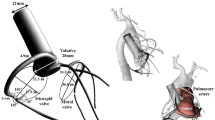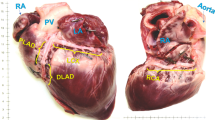Abstract
Intimal thickening in the coronary artery bypass graft (CABG) distal anastomosis has been implicated as the major cause of restenosis and long-term graft failure. Several studies point to the interplay between nonuniform hemodynamics including disturbed flows and recirculation zones, wall shear stress, and long particle residence time as possible etiologies. The hemodynamic features of two anatomic models of saphenous-vein CABGs were studied and compared. One simulated an anastomosis with both diameter and compliance mismatch and a curvature at the connection, analogous to the geometry observed in a conventional cardiothoracic procedure. The other, simulated an anastomosis with a flow stabilizing anastomotic implant connector which improves current cardiothoracic procedures by eliminating the distal vein bulging and curvature. Physiologic flow conditions were imposed on both models and qualitative analysis of the flow was performed with dye injection and a digital camera. Quantitative analysis was performed with laser Doppler velocimetry. Results showed that the presence of the bulge at the veno-arterial junction, contributed to the formation of accentuated secondary structures (helices), which progress into the flow divider and significantly affect radial velocity components at the host vessel up to four diameters downstream of the junction. The model with the implant, achieved more hemodynamically efficient conditions on the host vessel with higher mean and maximum axial velocities and lower radial velocities than the conventional model. The presence of the sinus may also affect the magnitude and shape of the shear stress at locations where intimal thickening occurs. Thus, the presence of the implant creates a more streamlined environment with more primary and less secondary flow components which may then inhibit the development of intimal thickening, restenosis, and ultimate failure of the saphenous vein graft. © 2002 Biomedical Engineering Society.
PAC2002: 8780Rb, 8719Rr, 8719Uv, 8763Lk, 8719Xx, 4262Be, 4780+v, 8710+e
Similar content being viewed by others
REFERENCES
Anayiotos, A. S., D. P. Giddens, S. A. Jones, S. Glagov, and C. K. Zarins. Shear stress at a compliant model of the human carotid bifurcation. J. Biomech. Eng. 116:98-106, 1994.
Asakura, T., and T. Karino. Flow patterns and spatial distribution of atherosclerotic lesions in human coronary arteries. Circ. Res. 66:1045-1066, 1990.
Bassiouny, H. S., S. White, S. Glagov, E. Choi, D. P. Giddens, and C. K. Zarins. Anastomotic intimal hyperplasia: mechanical injury or flow induced. J. Vasc. Surg. 15:708-717, 1992.
Berry, J. L., J. E. Moore, V. S. Newman, and W. D. Routh. In vitro flow visualization in stented arterial segments. J. Vasc. Invest. 3:63-68, 1997.
Berry, J. L., A. Santamaria, J. E. Moore, V. S. Newman, S. Roychowdhury, and W. D. Routh. In vitro flow visualization in stented arterial segments. Ann. Biomed. Eng. 28:386-398, 2000.
Braunwald, Heart Disease: A Textbook of Cardiovascular Medicine, 5th ed., 1997, pp. 1317-1326.
Butany, J. W., T. E. David, and M. Ojha. Histological and morphometric analyses of early and late aortocoronary vein grafts and distal anastomoses. Can. J. Cardiol. 14:671-677, 1998.
Canver, C. C. Conduit options in coronary artery bypass surgery. Chest 108:1150-1155, 1995.
Crawshaw, H., and W. Quist. Flow disturbance at the distal end-to-side anastomosis. Arch. Surg. (Chicago) 115:1280-1284, 1980.
David, G., and C. Andreas. Review of Physiology, Appleton and Langes', 1997.
Davies, P. F. Flow mediated endothelial mechanotransduction. Physiol. Rev. 75:519-560, 1995.
Echave, V., and A. Koornick. Intimal hyperplasia as a complication of the use of PTFE graft for femoral popliteal. Bypass Surg. 86:791-798, 1979.
Ethier, C. R., D. A. Steinman, X. Zhang, S. R. Karpik, and M. Ojha. Flow wave-form effects on end-to-side anastomotic flow patterns. J. Biomech. 31:609-617, 1998.
Guo, L., D. A. Steinman, B. C. Moon, W. Wan, and R. J. Milsap. Effect of distal graft anastomosis site on retrograde perfusion and flow patterns of native coronary vasculature. Ann. Thorac. Surg. 72:782-787, 2001.
Imparato, A., and A. Bracco. Intimal and neointimal fibrous proliferation causing failure of arterial reconstructions. Surgery (St. Louis) 72:1007-1017, 1972.
Keynton, R. S., S. E. Rittgers, and M. C. S. Shu. The effect of angle and flow upon hemodynamics in distal vascular graft anastomoses: An in vitro model study. J. Biomech. Eng. 113:458-463, 1991.
Ku, D., D. P. Giddens, C. K. Zarins, and S. Glagov. Pulsatile flow and atherosclerosis in the human carotid bifurcation: Positive correlation between plaque location and oscillating shear stress. Arteriosclerosis (Dallas) 5:293-302, 1985.
Lei, M., C. Kleinstreuer, and J. P. Archie. Hemodynamic simulations and computer-aided designs of graft-artery junctions. J. Biomech. Eng. 119:343-348, 1997.
Logerfo, F., and W. Quist. Downstream anastomotic hyperplasia: A mechanism of failure in Dacron arterial grafts. Ann. Surg. 197:479-483, 1987.
Louagie, Y., and J. P. Haxhe. Intraoperative electromagnetic flowmeter measurements in coronary artery bypass grafts. Ann. Thorac. Surg. 57:35-64, 1994.
Loth, F., S. A. Jones, D. P. Giddens, H. S. Bassiouny, S. Glagov, and C. K. Zarins. Measurements of velocity and wall shear stress inside a PTFE vascular graft model under steady flow conditions. J. Biomech. Eng. 119:187-94, 1997.
Lytle, B. W., F. D. Loop, and D. S. Cosgrove. Long term serial studies of internal mammary artery and saphenous vein coronary bypass grafts. J. Thorac. Cardiovasc. Surg. 89:248-258, 1995.
Ojha, M., C. R. Ethier, K. W. Johnston, and R. S. C. Cobbold. Steady and pulsatile flow in an end-to-side arterial anastomosis model. J. Vasc. Surg. 12:747-753, 1990.
Peacock, J., S. Hankins, T. Jones, and R. Lutz. Flow instabilities induced by coronary artery stents: Assessment with an in vitro pulse duplicator. J. Biomech. 28:17-26, 1995.
Sottiurai, V. S., J. S. T. Yao, R. C. Batson, S. L. Sue, R. Jones, and Y. A. Nakamura. Distal anastomotic hyperplasia: Histopathologic character and biogenesis. Ann. Vasc. Surg. 3:26-33, 1989.
White, S. S., C. K. Zarins, D. P. Giddens, H. Bassiouny, F. Loth, S. A. Jones, and S. Glagov. Hemodynamic patterns in two models of end-to-side vascular graft anastomoses: Effects of pulsatility, flow division, Reynolds number, and hood length. J. Biomech. Eng. 115:104-111, 1993.
Author information
Authors and Affiliations
Rights and permissions
About this article
Cite this article
Anayiotos, A.S., Pedroso, P.D., Eleftheriou, E.C. et al. Effect of a Flow-Streamlining Implant at the Distal Anastomosis of a Coronary Artery Bypass Graft. Annals of Biomedical Engineering 30, 917–926 (2002). https://doi.org/10.1114/1.1500407
Issue Date:
DOI: https://doi.org/10.1114/1.1500407




